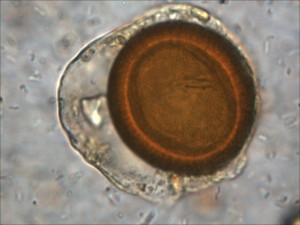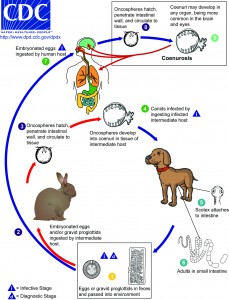The life cycle of Taenia tapeworm species involves a predator and a prey animal. The predator host the adult stage of the tapeworm in their intestine where the tapeworms reproduce sexually and produce eggs. For this reason the predator is termed the definitive host of Taenia species. These eggs are infectious when they leave their host with the faeces. Dogs and other canids are the definitive hosts of most Taenia species. Humans are the definitive hosts of Taenia solium (the pork tapeworm) and Taenia saginata (the beef tapeworm). Cats are the definitive hosts of Taenia taeniaeformis.
The prey animals become infected by ingesting infectious Taenia eggs.  The eggs hatch in the intestine and release their larvae. These juvenile larvae penetrate the wall of the intestine and circulate in the blood until they lodge in the tissues where the larva establishes a cyst which protect the larvae against hostile immune responses. The larva may grow in size or reproduce asexually inside the cyst and in this way increase the vital biomass. When the definitive host specie ingest the infected prey animal including living larvae in the cysts, the larvae grow to adult tapeworms and establish in the intestine. For this reason the prey animals are termed the intermediate hosts of Taenia.
The eggs hatch in the intestine and release their larvae. These juvenile larvae penetrate the wall of the intestine and circulate in the blood until they lodge in the tissues where the larva establishes a cyst which protect the larvae against hostile immune responses. The larva may grow in size or reproduce asexually inside the cyst and in this way increase the vital biomass. When the definitive host specie ingest the infected prey animal including living larvae in the cysts, the larvae grow to adult tapeworms and establish in the intestine. For this reason the prey animals are termed the intermediate hosts of Taenia.
 Many different animals may serve as intermediate hosts of Taenia species with dogs as their definitive hosts, including rodents, rabbits, horses, cattle, sheep, and goats. Humans may accidentally ingest such infectious Taenia eggs and become infected with juvenile larvae and their cysts. As humans are not prey animals and not eaten by definitive hosts, humans infected with the larval stage of Taenia are termed accidental hosts.
Many different animals may serve as intermediate hosts of Taenia species with dogs as their definitive hosts, including rodents, rabbits, horses, cattle, sheep, and goats. Humans may accidentally ingest such infectious Taenia eggs and become infected with juvenile larvae and their cysts. As humans are not prey animals and not eaten by definitive hosts, humans infected with the larval stage of Taenia are termed accidental hosts.
The definitive host of Taenia tapeworms are mostly unaffected by harbouring the tapeworm in their intestine with the exception that the tapeworm consume some of the nutrients passing by. In this way the definitive host will keep fit and able to spread the Taenia eggs in the environment. Dogs are spreading the eggs exceptionally well by never defecating in the same place. Maximal spread of the Taenia eggs is beneficial for the Taenia species and the defecation behaviour of dogs are perfectly adapted to the interests of the Taenia tapeworm.
The intermediate host infected with Taenia larvae/cysts may be affected in a number of ways. The detrimental effects of infection with Taenia multiceps larvae/cysts is well known in sheep and is termed coenurosis, “gid”, “sturdy” and “staggers”. The debilitation of the intermediate host of Taenia multiceps facilitates the predation of the animal and benefits the predator as well as the Taenia multiceps tapeworm.
The detrimental effects of infection in humans with Taenia solium (the pork tapeworm) larvae/cysts is well known as cysticercosis and neurocysticercosis. These infections have been eradicated in the rich part of the world. However, to which extent infection with Taenia larvae/cysts transmitted from dogs and cats (Taenia taeniaeformis) may cause similar diseases in humans has not been examined in a systematic way in medicine. Personally, I find it probable that infection with Taenia solium larvae/cysts is not the only Taenia infection that may cause disease, illnesses and ailments in humans. Time is long overdue to examine to which extent infection with Taenia larvae/cysts transmitted from dogs and cats is harmful to humans.
Taenia multiceps/serialis high resolusion pdf
Sincere thanks to Centers for Disease Control and Prevention, Division of Parasitic Diseases (CDC DPDx) for free use of illustrations.